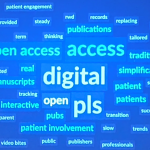Over recent years, the number of published medical articles that include patients as authors has risen. This trend has been driven by a shift across pharma companies towards patient involvement in research and the associated publications.
Both patients and pharma companies can benefit from collaborating during the development of a medical publication, ensuring that the published article reflects the views of multiple stakeholders including patients.
Despite the potential positives of patient co-authorship, several barriers remain. A recent survey indicated that about one-third of 112 journal editors were not supportive of patients co-authoring publications.
To gain a better understanding of the issues surrounding patient authorship, Open Pharma invited guest experts to present their experiences at our monthly topic meeting.
Pharma company benefits of including patients as authors
Publications featuring patients as authors are becoming more common.1 Recent updates to Good Publication Practice 2022 (GPP 2022) guidelines reflect this trend, with a notable new section of recommendations on the role of patients in biomedical publications.2
To understand this move towards greater inclusivity, it is useful to consider why pharma companies are motivated to involve patients in their publications. Pharma clients are “increasingly aware of the value that patients bring to the publication processes” says Dawn Lobban (Global Lead of Patient Partnerships at Envision Pharma Group). Patients can increase the value of a publication, in terms of reach, engagement and impact, by helping to ensure articles are relevant, easy to understand and, in those directly presenting the patient voice, trusted.
Our speakers’ collective experiences suggest, anecdotally, that patient co-authored publications that reflect the lived experience are of great interest to healthcare professionals. Pharma companies recognize that patient-led research, patient insight data and patient perspectives have the potential to improve medical research and associated literature.3 Quantifying these gains is extremely challenging and requires ongoing research.
Novel publication types and support resources
A range of new publication formats have been developed that can help to encourage patient involvement. These include special interest articles, standalone plain language summary publications (PLSPs), video abstracts, podcasts and specialist journals for patient co-authorship.
To support pharma companies and patients through this new collaborative landscape, open access evidenced-based recommendations4 and a bespoke website housing relevant resources (www.patientauthorship.com) are available. The website includes answers to frequently asked questions on a range of topics including authorship criteria, the publications process, disclosures and reimbursement, alongside comprehensive advice for pharma companies on how to identify and collaborate with patient partners.
For anyone who is interested in becoming a patient author, newly developed guidance resources are now freely available. In 2021, a European cancer patient network (Workgroup of European Cancer Patient Advocacy Networks [WECAN]) in collaboration with Envision Pharma Group launched a multi-pharma-funded free training course, which can be accessed here.
Patient authorship from the publishers’ perspective
Despite an increasing number of publishers embracing greater patient inclusivity, legacy thinking remains. Our speakers reassuringly have never witnessed a publication being rejected because of patient co-authorship. Yet, about a third of 112 Editors-in-Chief recently surveyed were not supportive of patient authorship.5 Joanne Walker (Co-Founder and Publishing Director at Becaris Publishing) believes “there’s quite a lot of work still to be done … educating journals, editors, publishers … [to provide evidence of] the value of having patient authors.”
Reticent publishers have expressed concerns about the extent to which patient authors can fulfil International Committee of Medical Journal Editors (ICMJE) authorship criteria when compared with other authors. Some publishers misinterpret the authorship criteria, believing that to fulfil them, patient authors must understand and contribute to every section of an article, including any complicated statistical methods or results. Speakers suggested that this could be due to a lack of understanding of how to implement ICMJE authorship criteria fairly across all author types and may involve a negative bias against the patient role and voice, particularly if qualitative in nature.
Refreshingly, the majority of journal publishers share the view of Laura Dormer (Co-Founder and Editorial Director at Becaris Publishing) and consider patients as “[an important] part of the publishing ecosystem.” Laura advised that the best way to ensure that patients do fulfil ICMJE criteria is to include them early in the publication process. GPP 2022 now recommends making sure that patients are given the opportunity to fulfil the criteria. Pharma companies and publishers need to consider patient needs when steering committees are planning publication timelines so that patients can contribute without it becoming an onerous burden.
Balancing fair reimbursement with the potential for bias
Another point of contention is whether patient authors should receive monetary reimbursement for their time and contribution. Patients and non-patients alike can be funded for particular roles, for instance, being part of a steering committee or a publication advisory board,2 but Jeri Burtchell (Patient author and advocate; Patient Subject Matter Expert, CorEvitas, LLC) reports that in her experience “co-authoring is an unpaid activity.”
Typically, HCPs aren’t paid for authorship either, but they gain additional value from co-authoring publications, for instance, career credit or institutional research recognition via the Research Excellence Framework. In contrast, patients often have to take time out of their working day or book annual leave to participate as authors, so do not receive the same benefits as HCPs.
GPP 2022 guidelines state that “Author agreements may state that authors will not receive payment in exchange for listing their name on a publication byline; however, this statement does not automatically disqualify from authorship professional medical writers or any other person earning a salary from professional activities that may confer authorship. Nor should such a statement be interpreted as a prohibition for compensating patients or other participants in publication activities, such as patient advocates or steering committee members, for their time.”
Some pharma companies have started to reimburse patient authors, but the majority don’t yet have a consistent policy. The collective perspective of the public, patients and pharma companies, is that they associate payment with the potential for bias and coercion, but without reimbursement, cost may present a significant barrier for some patients.
Patient authorship ‒ the authentic patient voice is powerful
Jeri Burtchell believes that “so much good can come from co-authoring experiences” if the topic resonates with the patient and if they are supported with sensitivity through the process. Besides directly empowering patients to express their authentic voice in the publication, patients with chronic illness provide years of experience expertise and “will often take what they’ve learned through the collaboration back to their communities to share and patient readers appreciate this inclusion, which helps build trust between pharma and the community.”Jeri has been co-authoring with Novartis and Oxford PharmaGenesis since 2015 demonstrating that “successful [co-authorship] collaborations can lead to long-lasting working relationships [that are fruitful and generate] … new and intriguing topics to explore.”
Jeri closed out the session with a poignant reminder. Many of those attending are motivated to work for the life science industry “to find new and better ways to improve the lives of patients” and that including patient perspectives will “bring that humanity [to their publications].”
References
1. Oliver J, Lobban D, Dormer L et al. Hidden in plain sight? Identifying patient-authored publications. Res Involv Engagem 2022; https://doi.org/10.1186/s40900-022-00346-w.
2. DeTora LM, Toroser D, Sykes A et al. Good Publication Practice (GPP) Guidelines for Company-Sponsored Biomedical Research: 2022 Update.Ann Intern Med 2022; https://doi.org/10.1186/s40900-020-00190-w.
3. Crocker JC, Ricci-Cabello I, Parker A, et al. Impact of patient and public involvement on enrolment and retention in clinical trials: systematic review and meta-analysis. BMJ 2018; https://doi.org/10.1136/bmj.k4738.
4. Arnstein L, Wadsworth AC, Yamamoto BA et al. Patient involvement in preparing health research peer-reviewed publications or results summaries: a systematic review and evidence-based recommendations. Res Involv Engagem 2020; https://doi.org/10.1186/s40900-020-00190-w.
5. Cobey KD, Monfaredi Z, Poole E et al. Editors-in-chief perceptions of patients as (co) authors on publications and the acceptability of ICMJE authorship criteria: a cross-sectional survey. Res Involv Engagem 2021; https://doi.org/10.1186/s40900-021-00290-1.
Jo Gordon is a Medical Writer at Oxford PharmaGenesis.






